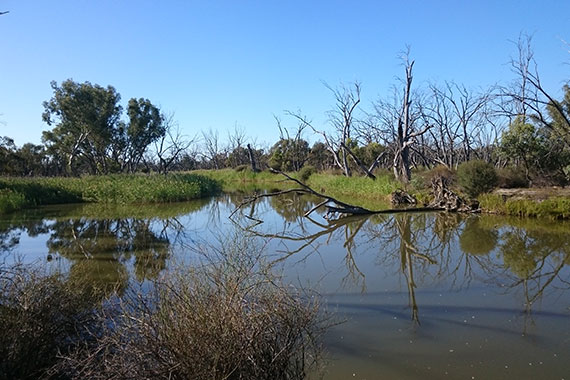Rainfall and inflows in western Victoria are highly variable and reflect the natural 'boom and bust' character of western Victorian rivers.
While the area flooded in late 2010 into 2011, it has been increasingly dry ever since.
In 2014–15, environmental water carried over from 2013–14 was critical in supporting western Victorian rivers and wetlands and the wildlife that depend on them.
In 2015–16, Australia is experiencing an El Niño event which is usually associated with below-average winter–spring rainfall over eastern Australia. With storage levels lowering, and uncertain weather conditions ahead, environmental water allocations in western Victoria are low. This means objectives for environmental watering in 2015–16 will focus on protecting water quality in the Wimmera and Glenelg systems to maintain habitat for native fish and animals.
Despite the dry outlook for the west, due to environmental watering in recent years Western region rivers are in a stronger position to bounce back when dry conditions ease. The work done by Wimmera and Glenelg Hopkins catchment management authorities in recent years has built the resilience of the river systems.
"The Glenelg River is definitely entering this dry period in better condition than it would have without environmental watering and careful planning over recent years," said Bryce Morden of Glenelg Hopkins Catchment Management Authority.
"We've had a remarkable four years of improvement in the river system and we are certainly entering these dry times with stronger populations of plants and animals and a game plan of how to manage the river through drier times."

In 2014–15, the Glenelg and Wimmera rivers were in the best condition they'd been in since before the drought. Monitoring in the Glenelg system showed that threatened native fish species and key recreational native fish species were present at more sites and in greater numbers. In the Wimmera, fish and vegetation monitoring were showing the best river conditions since monitoring began during the Millennium drought.
Both catchment management authorities believe securing environmental water for the river systems has been pivotal in their improvement.
"Before the Wimmera–Mallee pipeline was completed and our environmental water entitlement became more reliable, we had years in which there was no flow whatsoever in the lower Wimmera River," Greg Fletcher of Wimmera Catchment Management Authority said.
"In other years, we might have had a flow in the river for a few weeks but that was it. There wasn't the water available for fish and water bugs and other creatures to complete their lifecycles – to feed and breed and reproduce to create larger, stronger populations.
"We have seen this happen in the MacKenzie River where platypus are recolonising locations they abandoned during the drought."
"Now, with reduced water allocations expected for 2015–16, we might not have sufficient water for all of the rivers and creeks that rely on environmental water for their condition. However, we can manage water so that fish and other animals in refuge areas have more opportunity to complete their life cycle, and this sustains populations that, in wetter years, will be able to move into other parts of the system.
"As dry conditions worsen we may experience reductions in wildlife, but with a larger population base, there is less risk of catastrophic loss."
Bryce points out that river rehabilitation works in the Glenelg system have enabled environmental flows to strengthen the river and the life within it.
"Environmental flows, together with rehabilitation works, improve conditions within the river. For example, over the past decade, placement of large woody habitat and targeted removal of sand has improved fish habitat in the Glenelg River near Casterton.
"Environmental watering improves conditions around this habitat, cues fish migration to these areas, and increases water depth sufficiently for fish to move. We even designed and installed a fishway over a weir that works most effectively during environmental flows.
Despite these advances, Bryce notes that "we can't drought proof" the river. Unfortunately some plants are less resilient to drought and ultimately the river still needs larger flows to be sustained.
"The positive is that having some environmental water increases our ability to provide water to drought refuges and decreases our chances of long periods where the river ceases to flow. If, in good years, we can increase resilience – particularly for fish and water bugs – it is easier for the river to recover."